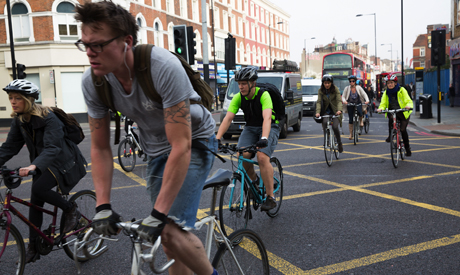Why ‘hip’ fixed gear cycling is on its knees

Change of gear?: Experts fear stripped-down aesthetic could have health costs. Photograph: Eleonore de Bonneval
You can tell a fixed-gear cyclist by the way they pedal.
Smooth, rotating constantly, even at walking pace.
That’s because, without freewheel, riders can’t take a break
from pedalling.
Occasionally you may see them riding backwards. In recent years ‘fixies’ have been hard to avoid.
The stripped-down aesthetic, low maintenance costs and association with hip New York City messengers appealed to trendsetters who have adopted them as their favoured mode of transport worldwide, and particularly in areas like Hackney.
But I’ve noticed fewer fixies lately, and the bike shop owners I’ve spoken to agree. So has the trend peaked, and if so, is this because of the alleged damage that fixed-gear cycling causes to riders’ knees?
As a cyclist and osteopath I needed to investigate.
But first a word about our hardworking knee joints.
We ask a lot of them. They perform a full range of movement under very high loads, absorbing shock and dealing with turning forces at full tilt when we change direction running.
They’re supported by the quadriceps muscles anteriorly and the hamstrings posteriorly.
Your kneecap or patella acts as a natural pulley, increasing the power generated by the quadriceps.
And here is where the problems usually start.
Riding fixed-gear is harder work than regular cycling. You don’t enjoy the mechanical advantage of gears, and because you can’t coast, your legs are the engine and brakes of the bike. This puts unusual forces on the knees especially when trying to start quickly or stopping at speed by locking up the rear wheel.
So, if badly ridden, pressure builds over the kneecap, forcing it down onto the bony surfaces below, and that’s when riders can develop pain in the front of the knee.
Other problems occur when seat height is incorrect or placed too far forwards or backwards.
Then the work discrepancy between the inner and outer quads can lead to the patella being pulled laterally, again causing pain over the knee.
But your knees can cope given time to adjust and a correct bike set-up. Greater work builds strength in the muscles and resilience in
the ligaments.
And because there is a gyroscopic effect with fixie wheels, your legs move more smoothly than on a freewheel.
Massage Therapist Robbie Emmanuel, who has ridden fixed for a number of years, thinks it is beneficial.
“You work both the quadriceps at the front and the hamstrings at the back. It feels a more balanced style of riding to me and I’ve yet to have any knee pain,” he says.
Other fixed riders I spoke to agreed. So what explains the decline in fixie numbers, other than just fashion? Well, my theory is that the people I spoke to were already cyclists when they started riding fixed.
The sudden appeal of fixed gear attracted people who may not have cycled for years and so were unaware of the importance of a good bike set-up. That combined with the innate competitiveness of the primarily 20-something male demographic led to some overstomping at the lights, overworking of the knees, and soon their fixed wheel days were over.
The key to happy, pain-free cycling is ensuring that you are set up well on your bike – whatever the gearing – but most importantly on a fixed
wheel cycle.
